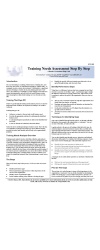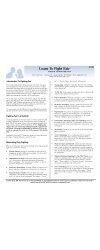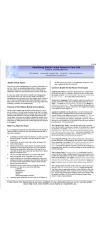Teams aren’t always the best or most efficient way to get work done
Sometimes Teams Are Counter-Productive
On the surface of it, it would appear that effective teams are always good, and that it is always worthwhile to invest in team-building activities. That worries me. So far I have found nothing that works as a panacea for the ills of everything, particularly in the area of organization improvement. We know that teams don’t always make the workplace better, in terms of work climate or productivity. The North American effort to transplant Japanese Quality Circles has taught us that at least some team-building efforts can result in chaos and negative outcomes.
So that we don’t become blindly enamored with the notion of teams we need to look at whether there are situations where a team-based workplace may not be effective, and where investment in team-building activities may be a wasted investment.
Teams Exist In a Context
When organization improvement efforts “go wrong”, it is often because implementers forget that anything that occurs in an organization exists within an organizational system, or context. When we forget this, and don’t consider related parts of the system, we get into trouble.
Teams work within an organizational context that will either support teamwork or discourage it. In some cases, other factors in an organization will totally preclude effective teamwork, and can suggest that a team-based workplace is inappropriate.
Let’s take a look at these factors.
Autocratic Leadership/Management
Some of the most bizarre things I have seen in organizations occur when autocratic managers or executives decide to force people to work in participatory teams. As often as not this occurs when the executive latches on to an idea or fad without a full understanding of its implications at all levels of the organization. In this situation, teamwork becomes something that is done TO people BY a manager or executive. While it is possible to legislate the structures of teams, and command their existence, it is not possible to order a team to work efficiently or harmoniously. In fact the use of power to create teams sows the seeds of destruction of those very teams. Not only does this not work but it can have disastrous consequences.
What happens when an autocratic approach is used with respect to teamwork?
- team members sense the contradiction between participatory teams and autocratic management. They don’t believe the rhetoric of the leader regarding his or her commitment to teamwork.
- There is a tendency for autocratic leaders to lack the skills needed to lead a team, so that teams end up directionless and confused. Some autocratic managers try so hard to “not be autocratic”, that they refuse to give any hints as to what the team is expected to accomplish. Other autocratic managers supply such rigid constraints for teams, that there is no point having a team at all.
- Autocratic leaders tend to use elastic authority. While they make a game attempt to “let go” of at least some power, they will quickly pull the elastic band to remove any autonomy that a team has. This elastic banding confuses teams since they can never tell what the bounds of their authority are, or, they realize it’s all a sham, and they have no autonomy or power anyway, just the appearance of it.
- When we have an autocratic executive in an organization, this makes effective teamwork at lower levels difficult, even though that work unit may have a more participatory leader. The work unit team may work as a team until they notice that someone “upstairs” is ignoring them, or rendering their ideas and work irrelevant or useless.
What results is:
- loss of credibility for management
- increased frustration on the part of team members
- difficulty in sustaining any team efforts difficulty in achieving even simple team goals
It might be better to forgo team development efforts where an autocratic manager is involved.
Predominance of Independent Job Tasks
Some tasks require teamwork, while some tasks are best done by a single individual working alone. Some require a mix. If you have a predominance of job tasks that are best done independently, then productivity can suffer if you try to shoehorn them into a team situation.
Writing is an example of a task that is best carried out by a single individual. Having more than one person working simultaneously on the same piece of work is likely to stop effective writing in its tracks, because teamwork disrupts a process that occurs primarily in a single brain.
Putting together an entire magazine, however, is an example of a mixed task. Some parts of the process, particularly the creative components, benefit from team involvement, and all tasks depend on team coordination.
Fire-fighting, however, is best done by a highly integrated team, because it is complex, and the safety of all depends on the ability of members of the team to act in a concerted way. That’s way we rarely hear of the superstar firefighter.
Now, here’s some criterion that can be used to determine if any given task is best carried out by a team, or an individual. At the end of the section, you will find a chart.
1. When tasks are simple…
…and repetitive, teams are unnecessary and may create higher “overhead”. Even if the overall task is complex but your organization breaks it down into teeny discrete tasks, a team may be unnecessary. An old style automobile assembly line is an example of a set of simple, discrete tasks that, when combined, yield a complex product.
Note that breaking done whole tasks into less meaningful little parts has some other negative effects, but if your organization does this, a team approach is useless without changing the way work is distributed and organized.
2. When tasks require little communication…
…between those carrying them out, putting them in a team context can result in reduced efficiency and frustration.
3. When the information needed to complete a task…
…is held entirely by one person, teamwork may disrupt the task.
4. When jobs are so unrelated that…
…each job or task can be carried out without the person knowing what another person is doing, teams may not increase productivity.
Rigidly Structured Hierarchical Organization
Almost every organization is structured in some hierarchical way. However, organizations differ in terms of the rigidity of that structure. The more flexible organization is characterized by increased delegation of authority to lower levels of the organization, flexible communication paths, and decentralized decision-making. The more rigid organization demands that its staff work through channels, refer most decisions to higher levels in the hierarchy, restrict autonomy and restrict communication. As a result of this rigidness, decision-making (and action) take a great deal of time.
A rigid hierarchical structure restricts individuals, but also teams. Teams below the “decision-making level” may work very effectively internally, but when they are faced with obtaining approvals through “channels”, their usefulness is curtailed. First, the process is two slow to sustain team commitment. Second, when teams realize that they have no authority to complete their tasks, they back-off, knowing that their work is not very meaningful. Thirdly, rigid organizations, by restricting communication, can limit a team’s effectiveness by reducing access to information that the team needs to succeed.
We won’t go so far as to say that teams cannot succeed in rigidly structured organizations, but we need to remember that teams are affected by the larger context in which they must operate. If you are considering a more team-based approach, and team-building activities, you need to consider whether the larger management system will render your team-building investment useless.
Preference For Individual-Based Work
Some people prefer to work in teams, while others have a preference for working more independently, or alone. It is possible that your workplace may be inhabited by a predominance of independent people who thrive on a higher degree of isolation from their co-workers. Moving to a more team-based approach may actually reduce the effectiveness of these people, while at the same time, increasing their frustration and even anger. This will be particularly the case if a team environment is perceived to “slow them down”, or reduce their autonomy. Not everyone wants to be a team member. What this means is that an attempt to force them into a team structure imposed upon them may be counter-productive particularly if there are no clear reasons for the team approach.
Extremely Unstable, Chaotic Workplace
A final consideration is the relative stability of the organization, its structure, mandate, staffing, etc. It is unlikely that any team will be effective when it must interface with different masters, when its role in the larger organization constantly changes, or when its own membership is always in flux.
Teams need some stability to function well. If your organization has a track record of constant change and disorganization, it may be wise to wait to initiate team-building processes until some stability is evident.
Conclusion
A team approach to work, and team-building exercises occur within the context of the entire organization. Some elements, like stability, rigidity and autocratic leadership may render team-building ineffective, or even counterproductive. Elements like task structuring, and employee preference for individual work also need to be considered before the decision to improve team functioning is made.
Teams are not a panacea, neither are they useless. It is important to consider the entire system of doing work, to determine if team-building, or a team-oriented approach is likely to justify the investment of time of effort needed.






